Themed collection Aggregation-Induced Emission with Bin Liu and Ben Zhong Tang

Aggregation-induced emission: fundamental understanding and future developments
In-depth discussion on recent progress of fundamental understanding of AIE mechanisms, identifying the existing challenges and opportunities for future developments.
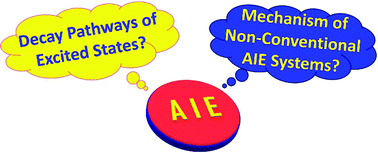
Mater. Horiz., 2019,6, 428-433
https://doi.org/10.1039/C8MH01331D
Improved pharmaceutical research and development with AIE-based nanostructures
AIE-based nanostructures may “lighten” drug research and development in the “dark”.

Mater. Horiz., 2018,5, 799-812
https://doi.org/10.1039/C8MH00648B
Recent progress in the mechanofluorochromism of cyanoethylene derivatives with aggregation-induced emission
This review provides a clear overview of the recent progress in the mechanofluorochromism of cyanoethylene derivatives with aggregation-induced emission.
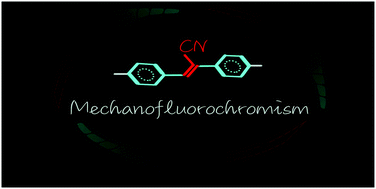
J. Mater. Chem. C, 2018,6, 6327-6353
https://doi.org/10.1039/C8TC01648H
A two-photon AIEgen for simultaneous dual-color imaging of atherosclerotic plaques
A smart color-switchable AIEgen for two-photon dual-color bioimaging of mouse atherosclerotic plaques with single-excitation is reported.
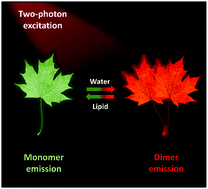
Mater. Horiz., 2019,6, 546-553
https://doi.org/10.1039/C8MH01293H
Triazatruxene-based small molecules with thermally activated delayed fluorescence, aggregation-induced emission and mechanochromic luminescence properties for solution-processable nondoped OLEDs
Thermally activated delayed fluorescence, aggregation-induced emission and mechanochromic luminescence properties are combined in triazatruxene-based small molecules, which exhibit low efficiency roll-off in OLED devices.
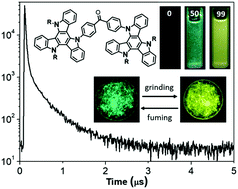
J. Mater. Chem. C, 2018,6, 12503-12508
https://doi.org/10.1039/C8TC04721A
AIE-based universal super-resolution imaging for inorganic and organic nanostructures
We propose an AIE-based universal super-resolution imaging scheme for inorganic and organic nanostructures with an optical resolution of 30 nm.
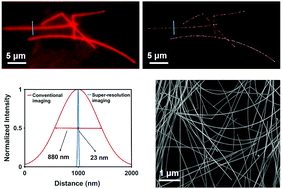
Mater. Horiz., 2018,5, 474-479
https://doi.org/10.1039/C8MH00089A
Utilizing formation of dye aggregates with aggregation-induced emission characteristics for enhancement of two-photon absorption
Femtosecond Z-scan measurements of aggregates of a quadrupolar D-π-D dye, provide direct evidence that aggregation of this AIE chromophore leads to a sizeable enhancement of the intrinsic two-photon absorption cross section.
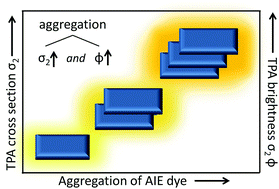
J. Mater. Chem. C, 2018,6, 4384-4388
https://doi.org/10.1039/C7TC05509A
High performance photosensitizers with aggregation-induced emission for image-guided photodynamic anticancer therapy
A series of D–A′–π–A type photosensitizers were designed and synthesized to show strong aggregation-induced far red and near infrared emission and very effective 1O2 generation simultaneously, and have been successfully used for image-guided photodynamic anticancer therapy.
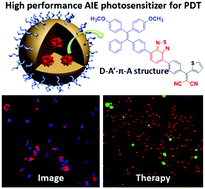
Mater. Horiz., 2017,4, 1110-1114
https://doi.org/10.1039/C7MH00469A
A stable tetraphenylethene derivative: aggregation-induced emission, different crystalline polymorphs, and totally different mechanoluminescence properties
Two crystalline polymorphs of TMPE (Cp-form and Cc-form) exhibit totally different mechanoluminescence properties.
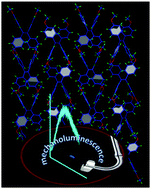
Mater. Horiz., 2016,3, 220-225
https://doi.org/10.1039/C6MH00025H
Direct evidence to support the restriction of intramolecular rotation hypothesis for the mechanism of aggregation-induced emission: temperature resolved terahertz spectra of tetraphenylethene
THz-TDS and computational modelling reveal temperature dependent structural changes that correlate with fluorescence.
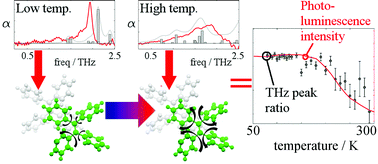
Mater. Horiz., 2014,1, 251-258
https://doi.org/10.1039/C3MH00078H
An easy-to-make strong white AIE supramolecular polymer as a colour tunable photoluminescence material
An easy-to-make small molecule-based strong white AIE supramolecular polymer acts as a multicolour tunable photoluminescence material.
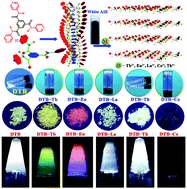
J. Mater. Chem. C, 2018,6, 13331-13335
https://doi.org/10.1039/C8TC04540B
New cationic Ir(III) complexes without “any soft substituents”: aggregation-induced emission and piezochromic luminescence
Two new aggregation-induced emission (AIE)-active cationic Ir(III) complexes with relatively rigid ligands have been rationally designed and synthesized, exhibiting excellent piezochromic luminescence (PCL) properties.
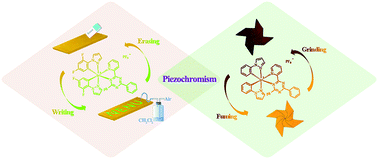
J. Mater. Chem. C, 2018,6, 12217-12223
https://doi.org/10.1039/C8TC04512G
AIE-active bis-cyanostilbene-based organogels for quantitative fluorescence sensing of CO2 based on molecular recognition principles
Fluorescence sensing of CO2 is achieved by the use of gel aggregates and xerogel systems made with the aggregation induced emissive bis-cyanostilbene derivative 1 reaching a detection limit as low as 4.5 ppm.
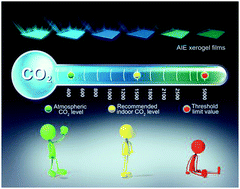
J. Mater. Chem. C, 2018,6, 9232-9237
https://doi.org/10.1039/C8TC01190G
Stimuli responsive AIE active positional isomers of phenanthroimidazole as non-doped emitters in OLEDs
Development of aggregation induced emission (AIE) active mechanochromic positional isomers of phenanthroimidazole comprising of triphenylamine and tetraphenylethylene.
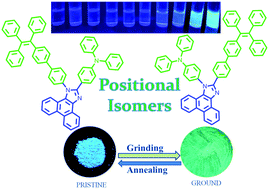
J. Mater. Chem. C, 2018,6, 2077-2087
https://doi.org/10.1039/C7TC05450E
Dramatic differences in the fluorescence of AIEgen-doped micro- and macrophase separated systems
A phase separated block copolymer and a polymer blend containing AIEgens with different polarities exhibit dramatically different fluorescence properties.
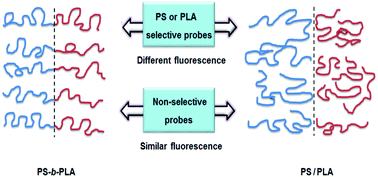
J. Mater. Chem. C, 2018,6, 171-177
https://doi.org/10.1039/C7TC04771A
About this collection
A themed collection on aggregation-induced emission (AIE) featuring articles specially selected by Professor Bin Liu, National University of Singapore, and Professor Ben Zhong Tang, Hong Kong University of Science and Technology.
AIE research has now drawn extensive attention and AIE luminogens (AIEgens) have been recognized as a novel type of advanced functional material with high-tech applications. This innovative concept has significantly changed the understanding of the scientific community toward classic photophysical phenomena and put forth a revolution of luminogenic materials research, both conceptually and technically. AIEgens show unique advantages such as high photostability, high brightness, large Stokes shift, and good biocompatibility, which provide a fantastic platform for the development of a wide spectrum of applications.
This themed collection showcases articles from deciphering the fundamental working mechanism, developing new AIE systems, to exploring applications in organic optoelectronic devices, chemical sensing, bioimaging and theranostics. An in-depth perspective on challenges and opportunities in AIE research is also presented.